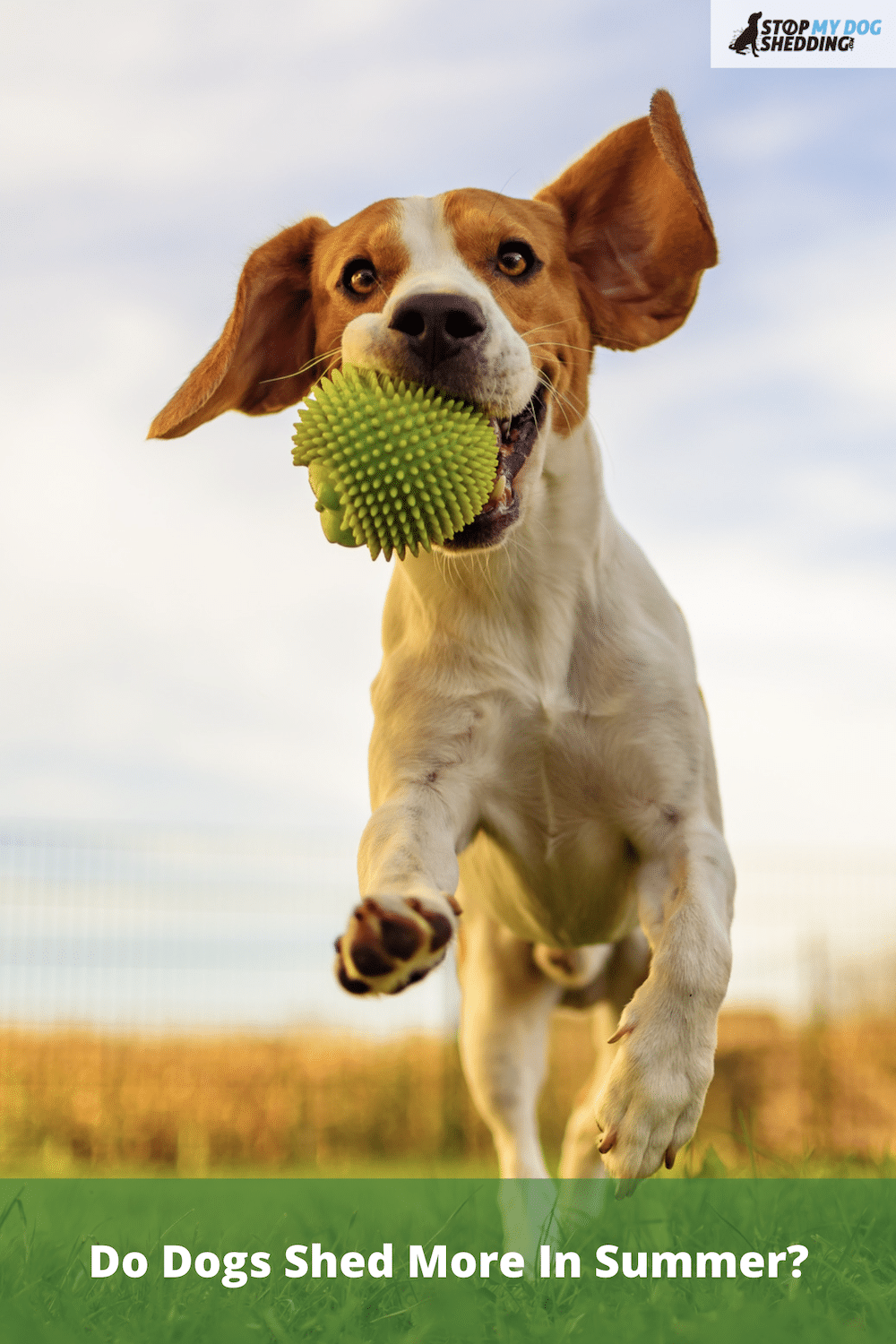When summer arrives, we shed those winter layers. So you may be wondering if your dog is more likely to lose fur during the warmer months compared to winter?
Dogs may shed more in the summer if they’re double-coated and undergoing seasonal coat changes because dogs blow their winter fur to stay cool.
However, if you notice an uptick in shedding and your dog doesn’t shed seasonally, then this could be due to pests, a nutritionally-deficient diet, over-bathing, or other factors.
So, in today’s guide, I’ll strive to answer all your questions about canine summertime shedding, including how long it lasts and how to deal with it, and show you what else to watch out for.
Let’s get started!
Recommended: Go here to see our top-rated dog hair blow dryers
Why Dogs Can Shed More in the Summer
Dogs are a lot like us humans. In the winter, they don’t want to be cold.
Sure, their bodies are covered in fur, but they could afford to be warmer still. So, whereas you’ll bust out the chunky-knit sweaters and bulky winter coats, your dog will grow more fur.
Then, in the summertime, it’s time to ditch all the heavy clothing and wear lighter outfits to beat the heat. Your dog is similarly eager for relief, so they once again change their coat.
What happens in both these wintertime and summertime periods is something that’s referred to as “blowing coat,” which occurs as a result of seasonal shedding.
And this is something that primarily happens among double-coated dogs.
A double-coated dog is one with a close-cropped insulating underlayer for warmth and an outer layer of guard hairs to repel dirt and grime.
Those layers thin out for the summertime, which can result in puffs, fluffs, and tufts of loose fur all over your house, upholstery, clothing; you name it, it’s there.
Seasonal shedding will occur either in late spring or early summer, depending on when the mercury begins rising. Even once your dog’s coat looks a lot thinner, the spike in shedding can persist.
It’s standard for these shedding spikes to last for weeks at a time. It’s no fun to start the summer season with a vacuum cleaner and a hand glove instead of a set of tongs and a pair of flip-flops, but you have to do it as a dog owner.
Recommended: Go here to see our top-rated dog hair blow dryers
Do All Dogs Shed More in the Summer?
With all that said, how you’ll kick off the start of summer depends on the individual dog breed you have. To reiterate, seasonal shedding mostly occurs in double-coated dogs. If your canine companion has but a single layer of fur, they probably won’t blow their coat.
Dogs with little to no hair, such as the Chinese Crested Dog (provided that yours is the hairless variety and not the Powderpuff), won’t shed much in the summer because they don’t shed much, period.
That said, since the hairless Chinese Crested Dog has mostly naked skin, you’d have to be diligent about applying sunblock every time you take your dog for a walk in the summer heat.
In any case, regardless of the breed, it’s important to note that all dogs with hair shed – even if they don’t blow their coat. While seasonal shedding won’t occur in all canines during the summer, they will still shed year-round because fur loss is normal among healthy dogs.
The only question is how much they’ll shed.
Assuming your dog isn’t suffering from any type of health issue (which I’ll elaborate more on shortly), one of the main determining factors as to how much loose fur you’ll notice comes down to the dog’s hair growth cycle.
In short, dogs grow fur in four stages. The last stage, exogen, is when the hair shafts release and shed from the body. And the speed at which dog fur goes through those four stages depends on the length of the hair. If a dog has a close-cropped, short coat, the hair doesn’t grow as long, so it’s onto the exogen stage before you know it.
This is why longer-haired dogs with single coats tend to shed less – because it takes more time for their coat to reach the exogen stage, and they only have one layer of fur.
There are many other factors that can contribute to shedding, though.
Ultimately, the rate of shedding will come down to the individual breed. And if you’re looking for the lowest shedding dogs, here are some posts you might find helpful:
Recommended: Go here to see our top-rated dog hair blow dryers
Tips for Dealing with Your Dog’s Seasonal Shedding
If your dog leaves your home covered in a layer of fur in the summertime, you have plenty of options for controlling their loose hair. Here’s what I recommend.
Brush Frequently
Above all else, regular grooming is your best defense against high rates of shedding, including seasonal shedding.
Brushing pulls out the loose fur before it falls out and spreads around your house. Your dog’s coat will look neater, and your home will be cleaner. It’s a win-win.
Another benefit of brushing your dog regularly is that the act of combing through their fur deposits oils across the skin.
These oils keep the skin moisturized. In the summertime, when moisture is in strong supply, maybe a dog doesn’t need this so much, but it’s still a benefit.
After all, when a dog’s skin is too dry and itchy, they scratch to the point of obsession. All that licking, scratching, and gnawing can worsen shedding.
As if those benefits weren’t good enough, you can also enjoy a smoother, glossier coat in your dog by brushing them.
You have all sorts of brushing tools you can use, from bristle brushes to pin brushes, slicker brushes, and even hand gloves.
This guide compares the types of dog brushes so you can select the best one depending on your canine’s fur length and texture. And this post shows you our top-rated de-shedding brushes and buyer’s guide to help you select which brush is best for your dog.
How often should you brush your dog? If they’re undergoing seasonal shedding, I would say every day or every other day.
When your dog doesn’t shed as profusely, brush them a few times a week or, at the very least, once per week.
Don’t Bathe Too Much
In the summertime, your dog is more eager than ever to splash into the pool or take a dip in the ocean.
They love swimming, but after they exit the water, you have to contend with the cleanup.
You shouldn’t leave chlorine or ocean salts in your dog’s skin and fur, but you also shouldn’t bathe them too much.
Most dogs do well with baths once per month. Other breeds can go several months before they should be plunked into the tub.
If you can help it, try to arrange your beach trips or pool days with your dog around the time that you were going to bathe them anyway.
Washing your dog too frequently can dry out their skin, even if you use dog-friendly shampoo. You already know that dry skin can increase the risk of shedding.
Invest in Great Deshedding Tools
Besides brushing your dog, I also recommend getting your hands on a de-shedding tool or two. A de-shedding brush reaches deep into both layers of a dog’s coat to pull out loose fur.
After your dog gets out of the tub or sink, using a dog hair blower does two jobs, drying your dog and removing loose tufts of hair that were going to come out anyway.
Use a Pet-Friendly Vacuum Cleaner
If you own a dog that sheds seasonally, then your everyday vacuum cleaner probably isn’t going to cut it for cleaning up tufts of fur. You’ll clog the vacuum and have to buy a new one.
A pet-hair-focused vacuum cleaner is designed for cleaning dog fur in large quantities. Your home will be cleaner faster, and your vacuum will live to see another season of shedding.
When Is Excessive Shedding a Concern?
Almost all dogs shed, and the amount might be a little noticeable, but nothing extreme. Even when your canine companion sheds seasonally, while that will be a lot of fur, this period lasts for just several weeks twice per year.
If your dog is shedding more than its breed should, it’s time to look into the following areas.
Is Your Dog’s Diet Optimal?
A dog whose diet is nutritionally deficient could shed as a consequence. All canines need a balanced diet full of minerals, vitamins, carbohydrates, fats, and proteins.
The problem with a lot of dog food is it’s full of filler and preservatives. Your dog could be eating the right amount of food for their size but still lack the nutrients they need to maintain healthy skin and a lustrous coat.
You might want to consider supplements for your pup, such as omega-3 fatty acids.
Another area of your dog’s diet that could cause them to shed excessively is food allergies. Your dog may experience an increased rate of diarrhea and vomiting when they eat.
If you suspect your dog might have a food allergy, bring them to the vet. Your vet may recommend removing ingredients from your dog’s food one by one, such as chicken or wheat, to determine which allergen(s) have aggravated their symptoms.
The best treatment for food allergies is typically avoidance, so you’ll have to be a careful and savvy shopper when buying dog food from now on.
Are You Grooming Your Dog Properly?
I’ve already discussed how important grooming is to the overall health of your dog and especially when it comes to reducing shedding. But to recap, brushing keeps your dog’s skin healthy, as does bathing your dog no more than once per month.
Does Your Dog Have a Health Issue?
Is your dog already on flea medication? If not, then it could be a pest infestation that has led to their higher-than-usual rate of shedding.
Tick bites are uncomfortable, and your dog will lick and scratch at the area the bite occurred. That area sheds, then another area, then another.
Bring your dog to your vet if you think they could have a flea problem. The vet will prescribe a flea treatment such as a shampoo, medication tablets, or a flea collar.
Shedding can also be caused by pregnancy, allergy, or an underlying health issue of some other kind, of which there are numerous possibilities.
As mentioned, all dogs shed, and some shed lots because… well, that’s what some dogs do! Not to mention, even if your dog is shedding more than normal, this could be due to seasonal shedding. So it’s not always cause for concern.
But if the shedding is patchy, your dog’s skin is red or irritated, or for whatever reason, you don’t believe the hair loss is “normal,” contact your local veterinarian. They should be able to advise you on what is going on and recommend what’s best for your dog.
Recommended: Go here to see our top-rated dog hair blow dryers
Bottom Line
Dogs will shed more in the summertime if they blow their coat, which typically applies to double-coated dogs (i.e., dogs with a top coat and undercoat). For dogs that don’t shed as the seasons change, they’ll still shed in the summer, but no more than any other time of the year.
And if you’re concerned about your dog’s rate of shedding, for any reason, it may be a good idea to take them to the vet. It could be that health issues such as fleas, nutrient deficiencies, or food allergies have caused their excessive shedding.













Please note: By submitting a comment using the above comment form, you confirm that you agree with the storage and handling of your data by this site as detailed in our Privacy Policy.